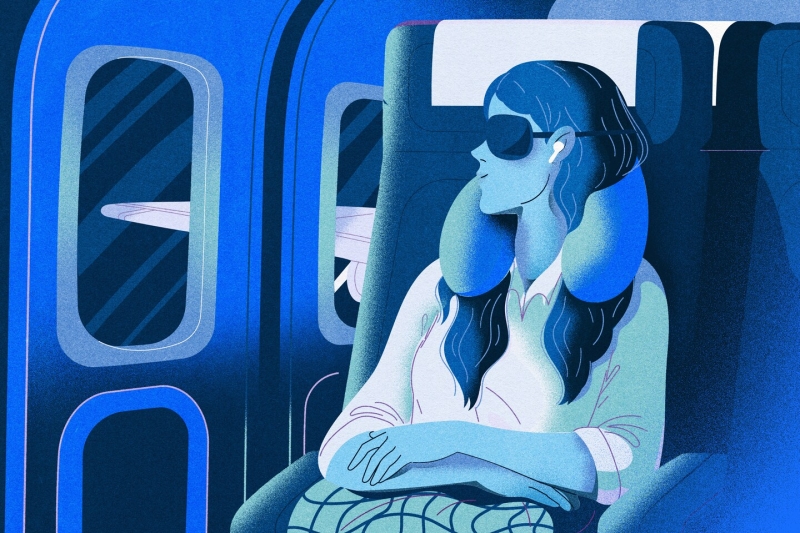Contents
What you eat before your flight, when you exercise and where you sit all affect how you sleep on an airplane.
Sorry, a summary is not available for this article at this time. Please try again later.

By Andrea Sachs
You may have seen these extraordinary beings on your red-eye flight: as soon as the plane takes off, they’re fast asleep, curled up in their coach seat like a baby in a bassinet. They sleep through meal service, turbulence and bawling infants.
It’s easy to resent these travelers because they have what you want: a solid night’s sleep on an overnight flight. But with the right mind-set and preparation, you can join them.
“A lot of people say, ‘Oh, I can’t sleep on a plane.’ Well, sure you can,” said Chris Winter, a neurologist and sleep specialist. “You’re creating your own reality. If the plane flies long enough and you’re on it long enough, you will fall asleep.”
Red-eye flights are the best idea and the worst. On the plus side, you gain more time in your destination and fly outside work hours, so you don’t have to waste vacation days on transiting. Fares are often less expensive than daytime flights. The downside is that you might not sleep well — or at all — and you’re a wreck the next day.
Many travelers, however, are not ready to ditch red-eyes, especially since Southwest recently announced plans to start offering them as part of its company overhaul. We spoke with sleep experts about how to help nocturnal fliers catch a few winks.
Take the latest flight
Philip Gehrman, an associate professor of clinical psychology at the University of Pennsylvania’s Penn Sleep Center, said super-late flights can work to your advantage. By the time you board, you will be so exhausted, you’ll need to prop up your eyelids.
Winter reminds travelers that it’s easier to force yourself to stay up late than to fall asleep if you’re not tired.
On connecting flights, the longest leg of the trip should occur during standard sleep times. Avoid layovers in the wee hours that will interrupt your sleep.
However, you should also consider your regular circadian rhythms. If you’re a night owl, pick a circa-midnight departure with a morning arrival that aligns with your usual wake-up time. If you’re more of a rooster, look for flights that leave and land earlier.
Get a window seat
The window seat is the master bedroom of economy. It allows you to insulate yourself from aisle traffic and seatmates who need to squeeze by to use the lavatory. You also get the wall. If you are tall or suffer from restless leg syndrome, choose an aisle seat.
Avoid last-minute workouts and meals
On the day of your trip, exercise as usual, but avoid high-intensity workouts close to your departure time. Physical exertion can release endorphins and raise your core temperature, both of which can sabotage sleep. In addition, eat dinner before you board.
“We generally say to avoid a heavy meal or any aerobic exercise for about an hour or an hour-and-a-half before you sleep, ” Gehrman said, “so that would apply to a flight as well.”
Whether you dine at home or in the airport, avoid hard to-digest or spicy foods that will sit in your belly. Stick with lean meats, nuts, dairy and complex carbs, which some sleep experts say can put the body in snooze mode. Winter said one of his favorite preflight snacks is hummus, which is high in tryptophan, an amino acid that helps produce melatonin and serotonin.
Avoid caffeine and alcohol
Obviously, skip caffeinated beverages and hydrate with water. Alcohol can be a shortcut to dreamland, but Gehrman warns that too many boozy drinks can cause shallow or fragmented sleep.
“I’ve had lots of people tell me they have a few drinks on the plane and that helps them fall asleep,” he said. “They may sleep, but it’s probably going to be pretty poor quality sleep.”
Block out light and noise
It seems so simple: You’re tired, so sleep. But airplane cabins do not have the same cues and comforts as a bedroom, so your body struggles to shut out the world and succumb to sleep.
The ceaseless stimulation — the glow of the seat-back screen, the flight crew announcements, the ping of the seat-belt sign, the snorts and snores of fellow passengers — keeps your brain active and your body alert. In addition, seated sleeping requires the muscles to work overtime.
“Sleeping in unfamiliar situations in which we don’t have control over sound, light or temperature can be challenging,” Joseph Dzierzewski, senior vice president of research and scientific affairs at the National Sleep Foundation, said by email. “Sleeping during flights also presents challenges regarding ideal sleeping position and the possibility of frequent uncontrollable interruptions.”
To block out the elements, pack an arsenal of sleep accessories, such as earplugs, an eye mask, a neck pillow and noise cancellation headphones. Winter is a fan of NapAnywhere, a travel pillow that resembles a tiny satellite dish and is less bulky than the more traditional model. He also suggests a hoodie with a built-in eye mask, such as the one by Dēp Slēpwear. Similar to new hiking equipment, test your sleep gear at home, to make sure it’s comfortable and works.
Wear layers for different temperatures
During the sleep cycle, the body’s core temperature drops and skin temperature rises. Between the chilly airplane and your fluctuating internal thermometer, you may feel as if you are bouncing between a sauna and a cold plunge. To avoid sweating or chattering teeth, dress in soft, loose-fitting layers, and bring a blanket and thick socks if you can’t sleep with your shoes on.
Bring your bedtime routine aboard
To prepare your body for sleep, replicate some of your at-home routines on the plane. If you drink a cup of tea or read before bed, practice these habits in your seat. Also, brush your teeth and wash your face in the airport bathroom or airplane lavatory, and remember to clean up any puddles.
“These sleep cues will help trigger your brain associations with bedtime,” Gehrman said.
Speed up recovery in your destination
Experts say the optimal amount of sleep for healthy adults is seven to nine hours. However, quality is as important as quantity. Deep sleep should account for 20 to 25 percent of your snooze time. Unfortunately, the most restorative phase of sleeping can be elusive on a plane. Even if you “sleep” for the entire flight, you could still wake up exhausted, with eyes the color of cherry tomatoes.
“It’s just a matter of getting what you can, knowing you’re going to feel tired the next day and planning ahead, ” Gehrman said. “On the first day in your destination, don’t plan anything that requires you to be alert and well-rested.”
To speed up recovery, exercise and get some sunlight. If you start dragging, take a short power nap, but don’t sleep for hours. And if you’re invited to dance the night away, politely decline until your circadian rhythms are back in their groove.
“You need to be really diligent about making sure your sleep is good for the next few nights,” Winter said. “You shouldn’t pull a red-eye and then party all night long in Prague.”
More travel tips
Vacation planning: Start with a strategy to maximize days off by taking PTO around holidays. Experts recommend taking multiple short trips for peak happiness. Want to take an ambitious trip? Here are 12 destinations to try this year — without crowds.
Cheap flights: Follow our best advice for scoring low airfare, including setting flight price alerts and subscribing to deal newsletters. If you’re set on an expensive getaway, here’s a plan to save up without straining your credit limit.
Airport chaos: We’ve got advice for every scenario, from canceled flights to lost luggage. Stuck at the rental car counter? These tips can speed up the process. And following these 52 rules of flying should make the experience better for everyone.
Expert advice: Our By The Way Concierge solves readers’ dilemmas, including whether it’s okay to ditch a partner at security, or what happens if you get caught flying with weed. Submit your question here. Or you could look to the gurus: Lonely Planet and Rick Steves.

